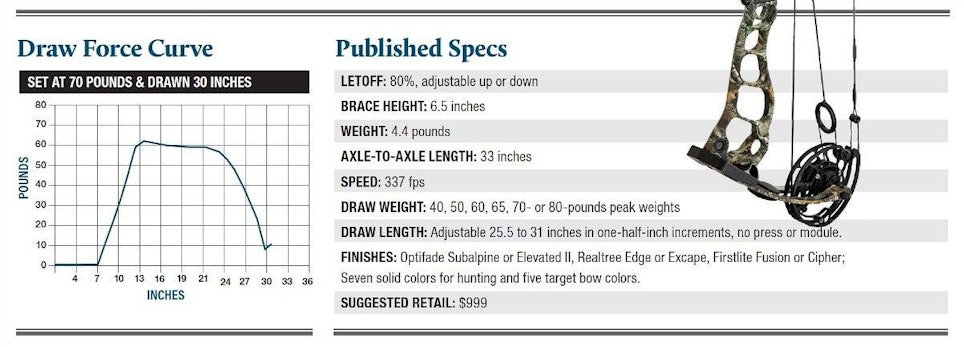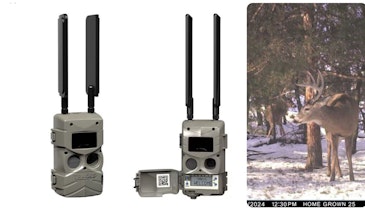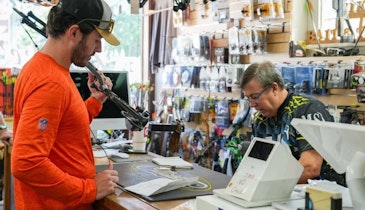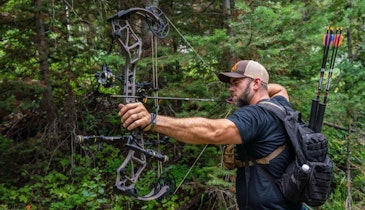Prime introduced the Black Series in 2020, consisting of the Black 1, Black 3, Black 5 and Black 9, characterized by some new design features. I tested the Black 3 model; the distinction between the models is mostly a matter of axle-to-axle length, along with some corresponding differences in brace height and speed, and of course, minor differences in the risers to accommodate the different lengths.
Despite some significant new features, the Black Series retains the unique parallel cam and Centergy technologies for which Prime has become known. As well they should. These design features distinguish Prime from all other bows on the market and, as I’ve pointed out in previous reviews, you needn’t be a physicist or an engineer to see the advantages of a wide, parallel cam system that all but eliminates torque, and the placement of the grip at the vertical center of the bow, as opposed to below it, for a balance that is unsurpassed (and probably unmatched) in the industry. The combination makes for an exceptionally stable shooting platform. Prime has conducted several interesting laser tests to provide evidence that most shooters do indeed hold Prime bows steadier at full draw.
The most significant new features involve the new cams (dubbed Roto Cams), which, though retaining the aforementioned parallel design, now offer adjustable draw lengths. By simply loosening two screws and removing a third on a module on each cam, the modules can be easily rotated and adjusted from 25.5 to 31 inches. The cable stops can be adjusted to alter let-off up or down from the factory-set 80%. Payouts on what amounts to this five-track system have moved from inside the cams to outside, with a yoke. In part to accommodate this, the Roto Cams are also wider than was previous designs, along with correspondingly wider split limbs and limb pockets, making an already stable platform even more so. The axles, too, are a little beefier on the Black Series bows.
Risers are similar to those on past models, including the use of Prime’s proprietary 82X aluminum, which Prime touts as stronger yet lighter than that found on other bows. The Centergy technology, as previously mentioned, is still a feature, along with the Prime’s signature Swerve, a curve in the riser which allows the riser below the grip to essentially be a mirror image of the riser above the grip, making for more consistent nock travel. Prime’s Flexis AR roller guard has been retained, as has the rear stabilizer mount on the Black 1, 3 and 5 models. Also, back from last year is Prime’s shim kit, which allows shims on either side of the axle to be moved for extremely-precise-tuning without changing center shot.
One interesting aspect of the five-track cam system with yokes is that the number of strings and cables totals seven pieces — a potentially expensive proposition to replace. To address that issue, Prime offers the Shield Program — simply by registering a new Prime bow, the owner is eligible, should it be necessary, for free string and cable replacement every two years for life.
The test bow in Optifade Elevated II was flawless in fit and finish.
Shooting the Prime Black 3
At my request, the Black 3 came factory set to IBO specs. It’s probably a reflection of Prime parent company G5’s reputation for precision engineering that Prime limb bolts are always snug but turn without resorting to a vice and without slipping or chattering, and that all accessories fit without difficulty and without the need to remove any paint or burrs from accessory threads. I was able to tune the bow without the need to move the shims.
At 4.4 pounds, the Black 3 is not lightweight, but is not inordinately heavy by current standards, especially for a bow of this length. I found the narrow side plate-style grip to be exceptionally comfortable. The highly touted balance will be noticeable to any shooter; the bow totally lacks the tendency of most compound bows (virtually all, in fact) to tip forward if held loosely in hand. The draw force curve indicates that the Black 3 remains at peak weight a little longer in the cycle than is the case for many bows, which accounts in part for its respectable speed. This is noticeable but is somewhat offset by the smoothness of the cycle. Unless they are drawing more weight than they should be, I don’t think most shooters will find it objectionable, and many will probably not notice it. At the shot, there is a slight vibration, significantly reduced by a stabilizer. The speed is evident. The Black 3 is no barn burner by any means — nor has Prime ever chased speed records — but in my experience, Prime bows tend to come closer to their published IBO speeds than is the case for those of many manufacturers. In any case, shooters looking for a barn burner will look elsewhere, as will shooters who prefer a compact, lightweight bow.
There is a reluctance to refer to any modern bow as accurate, given that a bow shooting machine, such as the Hooter Shooter I routinely use, can shoot dimes all day — assuming identical arrows from a well-tuned bow. But it’s undoubtedly true that some bows can be more easily shot with accuracy by a broader range of shooters than is the case for other bows. The balance, stability and steadiness at full draw make this, and in my experience, other Prime bows a hard choice to beat for bowhunters who put a premium on consistent accuracy in a bow that is pleasant shooting and plenty fast enough for any hunting scenario.
How We Test
- Each bow is carefully inspected out of the box for fit and finish and for any visible defects in workmanship. Axle-to-axle length, brace height, mass weight and draw length are measured and compared with stated specs. Minor discrepancies in draw length are corrected or noted.
- A QAD UltraRest is installed, and each bow is equipped with a TruGlo sight, a TruGlo stabilizer, a G5 1/4-inch Metapeep and a D-loop. Test arrows are Carbon Express Maxima Red arrows at weights of 385 and 440 grains, fletched with Bohning Blazer vanes and fitted with QAD Tune-A-Nocks. Peak draw weight is established, and draw force curves, along with letoff, are determined using an Easton Bow Force Mapping System.
- Using a Spot-Hogg Hooter Shooter bow-shooting machine and a ProChrono chronograph, arrow speed and kinetic energy are measured at point of launch and at 20 yards.
- Sound is measured with an NM102 Sound Level Meter with mic positioned 3 feet in front of the bow and 18 inches under the arrow flight path.
- All bows are pressed on a Buckeye Archery Solutions Bow-A-Constrictor press.









